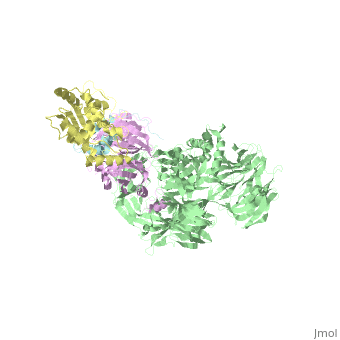Vpr protein
From Proteopedia
| Line 5: | Line 5: | ||
=== Vpr induce cell cycle arrest by recruits cellular targets for degradation<ref>PMID:27571178</ref> === | === Vpr induce cell cycle arrest by recruits cellular targets for degradation<ref>PMID:27571178</ref> === | ||
| - | One phenotype of Vpr expression is the induction of cell cycle arrest in G2 phase. This arrest executes by engaging of DNA damage–binding protein 1 (DDB1) and CUL4A-associated factor 1 (DCAF1) to Vpr. DCAF1 is a substrate receptor of the Cullin4–RING E3 ubiquitin ligase (CRL4) of the host ubiquitin–proteasome-mediated protein degradation pathway. Mutations in Vpr that abolish its interaction with DCAF1, or silencing of DCAF1, eliminate cell-cycle arrest. | + | One phenotype of Vpr expression is the induction of cell cycle arrest in G2 phase. This arrest executes by engaging of DNA damage–binding protein 1 (DDB1) and CUL4A-associated factor 1 (DCAF1) to Vpr. DCAF1 is a substrate receptor of the Cullin4–RING E3 ubiquitin ligase (CRL4) of the host ubiquitin–proteasome-mediated protein degradation pathway. Mutations in Vpr that abolish its interaction with DCAF1, or silencing of DCAF1, eliminate cell-cycle arrest. The crystal structure of DDB1–DCAF1–HIV-1–Vpr–uracil-DNA glycosylase (UNG2) complex elucidate the molecular mechanism in which Vpr inhibits DDB1 enzymatic activity and send it for degradation. |
| - | + | * Vpr binding to the DCAF1 WD40 by its N-terminus and α3 helix. <br/> | |
| + | * Vpr uses structural mimicry to DNA to engages UNG2. <br/> | ||
| + | * DCAF1 is anchored into DDB1 by a helix-loop-helix motif <br/> | ||
| + | |||
== Disease == | == Disease == | ||
HIV-1 retrovirus is the cause of AIDS disease. HIV-1 is a RNA virus which copy its genome to the host-cell genome in infect cells. HIV-1 infects activated CD4 immune cells and macrophages. When the disease is expressing in carriers, the progressive depletion of CD4 T cells causes immunodeficiency<ref name='Emerman1996'>PMID:8805364</ref>. | HIV-1 retrovirus is the cause of AIDS disease. HIV-1 is a RNA virus which copy its genome to the host-cell genome in infect cells. HIV-1 infects activated CD4 immune cells and macrophages. When the disease is expressing in carriers, the progressive depletion of CD4 T cells causes immunodeficiency<ref name='Emerman1996'>PMID:8805364</ref>. | ||
Revision as of 00:32, 8 April 2018
| |||||||||||
3D Structures of Vpr protein
Updated on 08-April-2018
1m8l – Vpr - NMR - HIV-1
1esx - synthetic Vpr - NMR - HIV-1
5jk7 – Vpr + DDB1 + DCAF-1 + UNG2 – X-ray solution - HIV-1
1x9v – Dimeric structure of the Vpr C-terminal domain - NMR
1vpc - C-terminal domain of Vpr - NMR - HIV-1
1fi0 - Vpr residues 13-33 in micelles - NMR - HIV-1
1bde - NMR solution of Vpr peptides connected to cell cycle arrest and nuclear provirus transfer
5b56 - Importin subunit alpha-1 + Vpr C-terminal domain - crystallographic analysis
1kzs, 1kzt, 1kzv - Vpr residues 34-51 - NMR - HIV-1
1dsj - Vpr residues 50-75 - NMR - HIV-1
1ceu - Vpr N-terminal domain - NMR - HIV-1
1dsk - Vpr residues 59-86 - NMR - HIV-1
References
- ↑ 1.0 1.1 Morellet N, Bouaziz S, Petitjean P, Roques BP. NMR structure of the HIV-1 regulatory protein VPR. J Mol Biol. 2003 Mar 14;327(1):215-27. PMID:12614620
- ↑ 2.0 2.1 Gonzalez ME. The HIV-1 Vpr Protein: A Multifaceted Target for Therapeutic Intervention. Int J Mol Sci. 2017 Jan 10;18(1). pii: ijms18010126. doi: 10.3390/ijms18010126. PMID:28075409 doi:http://dx.doi.org/10.3390/ijms18010126
- ↑ Wu Y, Zhou X, Barnes CO, DeLucia M, Cohen AE, Gronenborn AM, Ahn J, Calero G. The DDB1-DCAF1-Vpr-UNG2 crystal structure reveals how HIV-1 Vpr steers human UNG2 toward destruction. Nat Struct Mol Biol. 2016 Aug 29. doi: 10.1038/nsmb.3284. PMID:27571178 doi:http://dx.doi.org/10.1038/nsmb.3284
- ↑ 4.0 4.1 Emerman M. HIV-1, Vpr and the cell cycle. Curr Biol. 1996 Sep 1;6(9):1096-103. PMID:8805364

